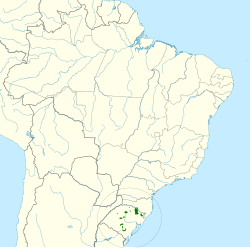| Red-spectacled amazon | |
|---|---|
 | |
| In Brazil | |
| Scientific classification | |
| Kingdom: | Animalia |
| Phylum: | Chordata |
| Class: | Aves |
| Order: | Psittaciformes |
| Family: | Psittacidae |
| Genus: | Amazona |
| Species: | A. pretrei |
| Binomial name | |
| Amazona pretrei (Temminck, 1830) | |
 | |
The red-spectacled amazon (Amazona pretrei) is a species of parrot in the family Psittacidae. It is found in Argentina, Brazil, and Paraguay.
Contents
Its natural habitats are subtropical or tropical dry forest, subtropical or tropical moist lowland forest, subtropical or tropical moist montane forest, dry savanna, and plantations. It is threatened by habitat loss.
The Red-spectacled Amazon migrates seasonally from the northern region of the state of Rio Grande do Sul to the south-eastern state of Santa Catarina to feed on the mass-produced seeds of the Brazilian Pine. [3]
The species is distributed in the area of the frontier between southern Corrientes province in Argentina and the state of Rio Grande do Sul, Brazil. [4]
They are a quiet species with a relaxed disposition. [4]

